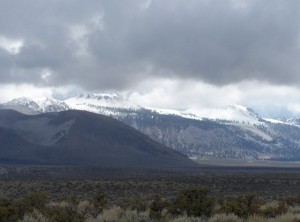
October 1, 2010 was the first day of the 2011 Water Year—Happy New Year! A Water Year in the Mono Basin runs from October 1 to September 30th. This lumps the winter’s precipitation into the same year as the following summer’s runoff, as well as the next year’s growing season.
The 2010 Water Year (October 1, 2009 — September 30, 2010) was near-normal for precipitation and runoff. In Lee Vining we measured 108% of average precipitation, and in the four streams diverted by DWP, about 103% of average runoff was measured. Mono Lake fell a tenth of a foot over the course of the year, due to a warm, dry August, during which Mono Lake fell a tenth of a foot more than the previous August. Monthly and annual lake levels, as well as monthly (unofficial) weather summaries and an updated rainfall spreadsheet can be found on the Mono Basin Clearinghouse.
After a very dry August and September, the 2011 Water Year has started with a splash, and Lee Vining has already received almost two inches of rain as of today. The October record of 2.41 inches of rain (set in 1991) is in jeopardy with more rain in this week’s forecast. Tioga and Sonora Passes closed yesterday morning and by 2:00 pm that day, Tioga Pass already had four inches of new snow. See historic Tioga Pass opening and closing dates here.
This week, the flow in Parker Creek doubled and in Walker Creek tripled due to the rain. See the real-time data website for up-to-the-minute streamflows from DWP, with explanations for each station provided by the Mono Lake Committee.

